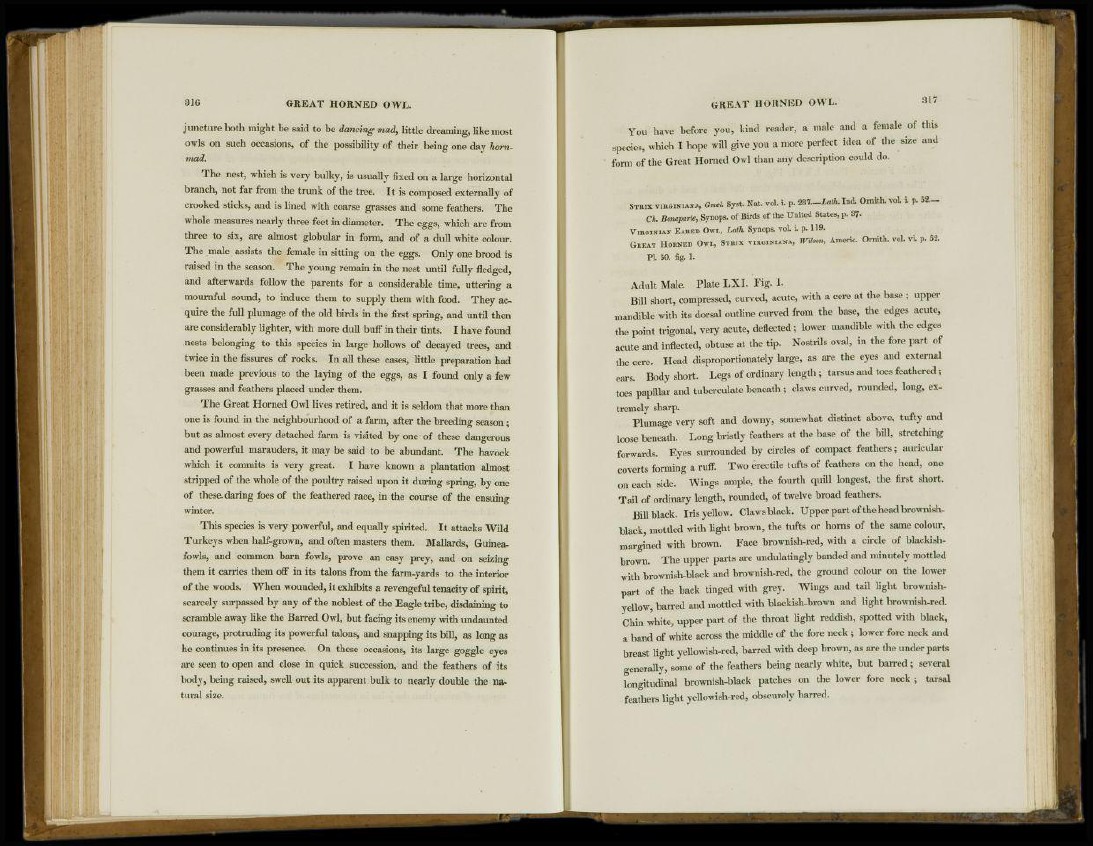
3J6 GREAT HORNED OWL.
juncture both might be said to be dancing mad, little dreaming, like most
owls on such occasions, of the possibility of their being one day hornmad.
The nest, which is very bulky, is usually fixed on a large horizontal
branch, not far from the trunk of the tree. It is composed externally of
crooked sticks, and is lined with coarse grasses and some feathers. The
whole measures nearly three feet in diameter. The eggs, which are from
three to six, are almost globular in form, and of a dull white colour.
The male assists the female in sitting on the eggs. Only one brood is
raised in the season. The young remain in the nest until fully fledged,
and afterwards follow the parents for a considerable time, uttering a
mournful sound, to induce them to supply them with food. They acquire
the full plumage of the old birds in the first spring, and until then
are considerably lighter, with more dull buff in their tints. I have found
nests belonging to this species in large hollows of decayed trees, and
twice in the fissures of rocks. In all these cases, little preparation had
been made previous to the laying of the eggs, as I found only a few
grasses and feathers placed under them.
The Great Horned Owl lives retired, and it is seldom that more than
one is found in the neighbourhood of a farm, after the breeding season;
but as almost every detached farm is visited by one of these dangerous
and powerful marauders, it may be said to be abundant. The havock
which it commits is very great. I have known a plantation almost
stripped of the whole of the poultry raised upon it during spring, by one
of these, daring foes of the feathered race, in the course of the ensuing
winter.
This species is very powerful, and equally spirited. It attacks Wild
Turkeys when half-grown, and often masters them. Mallards, Guineafowls,
and common barn fowls, prove an easy prey, and on seizing
them it carries them off in its talons from the farm-yards to the interior
of the woods. When wounded, it exhibits a revengeful tenacity of spirit,
scarcely surpassed by any of the noblest of the Eagle tribe, disdaining to
scramble away like the Barred Owl, but facing its enemy with undaunted
courage, protruding its powerful talons, and snapping its bill, as long as
he continues in its presence. On these occasions, its large goggle eyes
are seen to open and close in quick succession, and the feathers of its
body, being raised, swell out its apparent bulk to nearly double the natural
size.
GREAT HORNED OWL. 317
You have before you, kind reader, a male and a female of this
species, which I hope will give you a more perfect idea of the size and
form of the Great Horned Owl than any description could do.
S T R I X V I R G I N I A N A , Gmel. Syst. Nat. vol. i. p. 287.—Lath. Ind. Ornith. vol. i. p. 5 2 —
Ch. Bonaparte, Synops. of Birds of the United States, p. 3 7 .
V I R G I N I A N E A R E D OWL, Lath. Synops. vol. i. p. 119.
G R E A T H O R N E D OWL, S T R I X V I R G I N I A N A , Wilson, Americ. Ornith. vol. vi. p. 52.
PI. 50. fig. 1.
Adult Male. Plate LXI. Fig. 1.
Bill short, compressed, curved, acute, with a cere at the base ; upper
mandible with its dorsal outline curved from the base, the edges acute,
the point trigonal, very acute, deflected; lower mandible with the edges
acute and inflected, obtuse at the tip. Nostrils oval, in the fore part of
the cere. Head disproportionately large, as are the eyes and external
ears. Body short. Legs of ordinary length ; tarsus and toes feathered ;
toes papillar and tuberculate beneath ; claws curved, rounded, long, extremely
sharp.
Plumage very soft and downy, somewhat distinct above, tufty and
loose beneath. Long bristly feathers at the base of the bill, stretching
forwards. Eyes surrounded by circles of compact feathers; auricular
coverts forming a ruff. Two erectile tufts of feathers on the head, one
on each side. Wings ample, the fourth quill longest, the first short.
Tail of ordinary length, rounded, of twelve broad feathers.
Bill black. Iris yellow. Claws black. Upper part of the head brownishblack,
mottled with light brown, the tufts or horns of the same colour,
margined with brown. Face brownish-red, with a circle of blackishbrown.
The upper parts are undulatingly banded and minutely mottled
with brownish-black and brownish-red, the ground colour on the lower
part of the back tinged with grey. Wings and tail light brownishyellow,
barred and mottled with blackish-brown and light brownish-red.
Chin white, upper part of the throat light reddish, spotted with black,
a band of white across the middle of the fore neck ; lower fore neck and
breast light yellowish-red, barred with deep brown, as are the under parts
generally, some of the feathers being nearly white, but barred; several
longitudinal brownish-black patches on the lower fore neck ; tarsal
feathers light yellowish-red, obscurely barred.